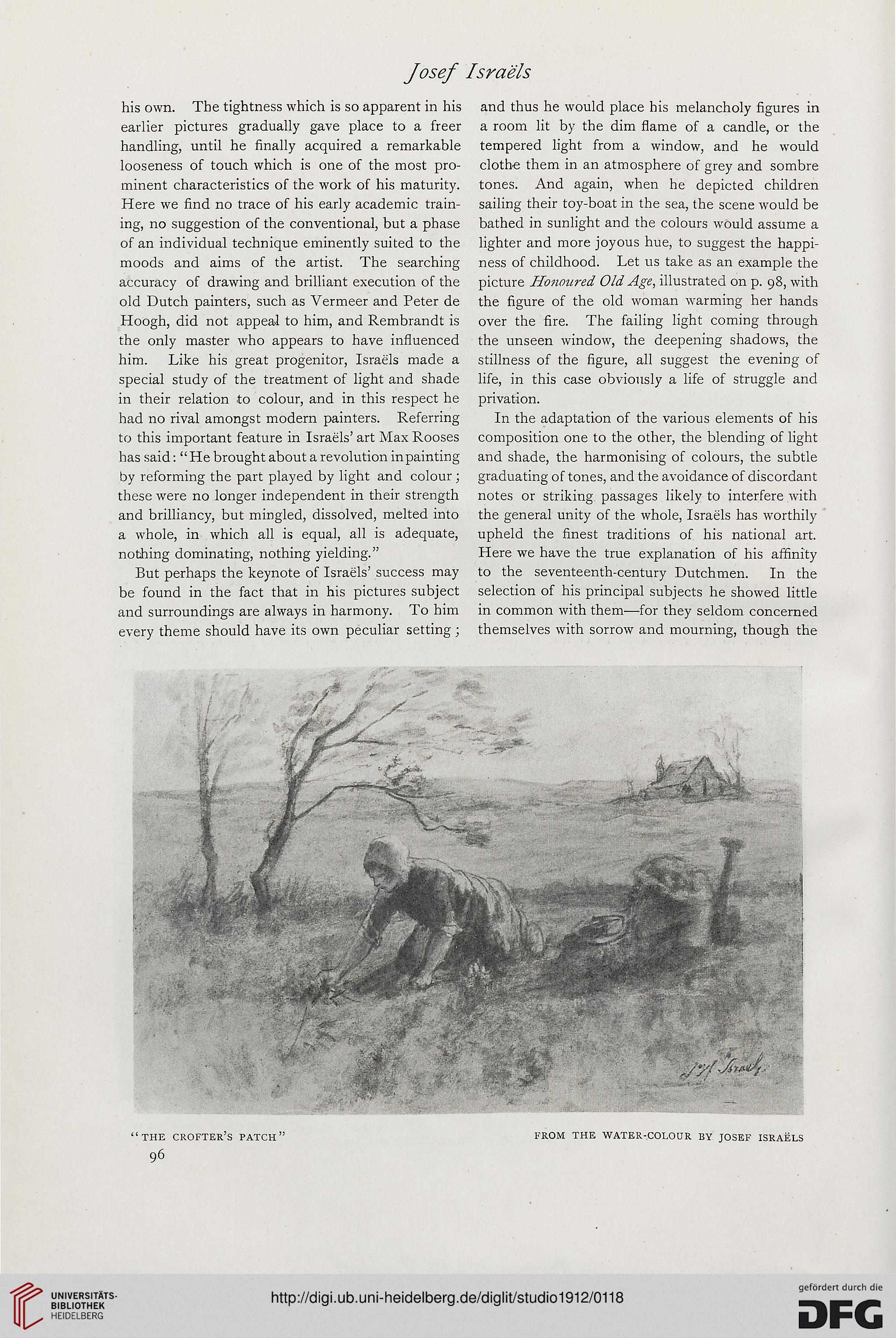Josef Israels
his own. The tightness which is so apparent in his and thus he would place his melancholy figures in
earlier pictures gradually gave place to a freer a room lit by the dim flame of a candle, or the
handling, until he finally acquired a remarkable tempered light from a window, and he would
looseness of touch which is one of the most pro- clothe them in an atmosphere of grey and sombre
minent characteristics of the work of his maturity, tones. And again, when he depicted children
Here we find no trace of his early academic train- sailing their toy-boat in the sea, the scene would be
ing, no suggestion of the conventional, but a phase bathed in sunlight and the colours would assume a
of an individual technique eminently suited to the lighter and more joyous hue, to suggest the happi-
moods and aims of the artist. The searching ness of childhood. Let us take as an example the
accuracy of drawing and brilliant execution of the picture Honoured Old Age, illustrated on p. 98, with
old Dutch painters, such as Vermeer and Peter de the figure of the old woman warming her hands
Hoogh, did not appeal to him, and Rembrandt is over the fire. The failing light coming through
the only master who appears to have influenced the unseen window, the deepening shadows, the
him. Like his great progenitor, Israels made a stillness of the figure, all suggest the evening of
special study of the treatment of light and shade life, in this case obviously a life of struggle and
in their relation to colour, and in this respect he privation.
had no rival amongst modern painters. Referring In the adaptation of the various elements of his
to this important feature in Israels' art Max Rooses composition one to the other, the blending of light
has said: "He brought about a revolution in painting and shade, the harmonising of colours, the subtle
by reforming the part played by light and colour; graduating of tones, and the avoidance of discordant
these were no longer independent in their strength notes or striking passages likely to interfere with
and brilliancy, but mingled, dissolved, melted into the general unity of the whole, Israels has worthily
a whole, in which all is equal, all is adequate, upheld the finest traditions of his national art.
nothing dominating, nothing yielding." Here we have the true explanation of his affinity
But perhaps the keynote of Israels' success may to the seventeenth-century Dutchmen. In the
be found in the fact that in his pictures subject selection of his principal subjects he showed little
and surroundings are always in harmony. To him in common with them-—for they seldom concerned
every theme should have its own peculiar setting ; themselves with sorrow and mourning, though the
'THE CROFTER'S PATCH" FROM THE WATER-COLOUR BY JOSEF ISRAELS
96
his own. The tightness which is so apparent in his and thus he would place his melancholy figures in
earlier pictures gradually gave place to a freer a room lit by the dim flame of a candle, or the
handling, until he finally acquired a remarkable tempered light from a window, and he would
looseness of touch which is one of the most pro- clothe them in an atmosphere of grey and sombre
minent characteristics of the work of his maturity, tones. And again, when he depicted children
Here we find no trace of his early academic train- sailing their toy-boat in the sea, the scene would be
ing, no suggestion of the conventional, but a phase bathed in sunlight and the colours would assume a
of an individual technique eminently suited to the lighter and more joyous hue, to suggest the happi-
moods and aims of the artist. The searching ness of childhood. Let us take as an example the
accuracy of drawing and brilliant execution of the picture Honoured Old Age, illustrated on p. 98, with
old Dutch painters, such as Vermeer and Peter de the figure of the old woman warming her hands
Hoogh, did not appeal to him, and Rembrandt is over the fire. The failing light coming through
the only master who appears to have influenced the unseen window, the deepening shadows, the
him. Like his great progenitor, Israels made a stillness of the figure, all suggest the evening of
special study of the treatment of light and shade life, in this case obviously a life of struggle and
in their relation to colour, and in this respect he privation.
had no rival amongst modern painters. Referring In the adaptation of the various elements of his
to this important feature in Israels' art Max Rooses composition one to the other, the blending of light
has said: "He brought about a revolution in painting and shade, the harmonising of colours, the subtle
by reforming the part played by light and colour; graduating of tones, and the avoidance of discordant
these were no longer independent in their strength notes or striking passages likely to interfere with
and brilliancy, but mingled, dissolved, melted into the general unity of the whole, Israels has worthily
a whole, in which all is equal, all is adequate, upheld the finest traditions of his national art.
nothing dominating, nothing yielding." Here we have the true explanation of his affinity
But perhaps the keynote of Israels' success may to the seventeenth-century Dutchmen. In the
be found in the fact that in his pictures subject selection of his principal subjects he showed little
and surroundings are always in harmony. To him in common with them-—for they seldom concerned
every theme should have its own peculiar setting ; themselves with sorrow and mourning, though the
'THE CROFTER'S PATCH" FROM THE WATER-COLOUR BY JOSEF ISRAELS
96




